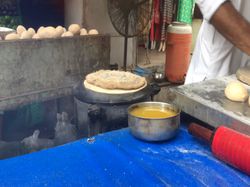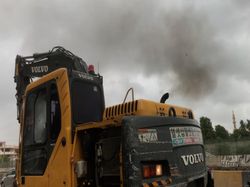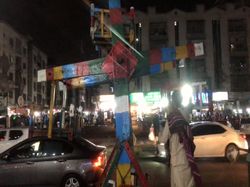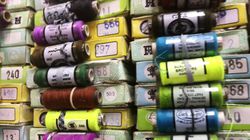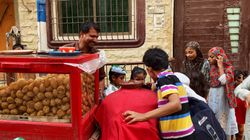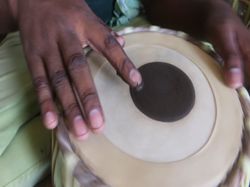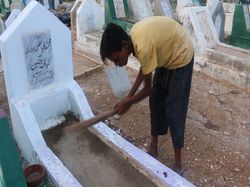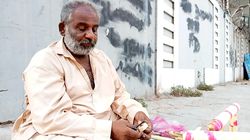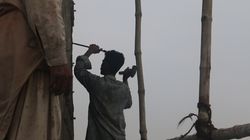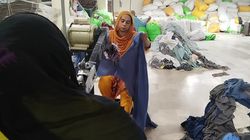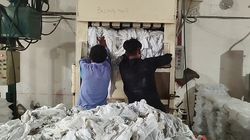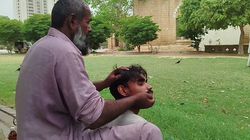
Karachi|Pakistan
Statistical Data
Founding in 1729, as the fishing village of Kolachi (although the territory has been populated for many millennia), founded by Baloch chieftain Mir Mahmood.
https://earth.esa.int/web/earth-watching/historical-views/content/-/article/karachi-pakistan/
Surface area 3527 sq. km
https://en.wikipedia.org/wiki/List_of_largest_cities
POPULATION
According to Pakistan Bureau of Statistics, the population is over 20.3 million as of 2023, by far the highest of any city in the country. Yet, citizens and politicians have questioned the result, saying Karachi’s population is above 25 million.
https://www.pbs.gov.pk/sites/default/files/population/2023/Sindh.pdf
https://arynews.tv/karachi-population-digital-census-rises-20-mln/
https://www.dawn.com/news/1702463
Population Growth Rate 4.10
https://www.pbs.gov.pk/sites/default/files/population/2023/Sindh.pdf
Average Household size 5.93
https://www.pbs.gov.pk/sites/default/files/population/2023/Sindh.pdf
Old Names of Karachi
Kolachi Jo Goth – The new settlement under the rule of Kalhora Dynasty in 1729 was named after Mai Kolachi. According to legend, Mai Kolachi’s son is said to have slain a crocodile after it killed his brothers.
Karachee – a shortened version of Kolachi Jo Goth
Krokola – ancient name by which some scholars identify it. Krokola port is where Alexander the Great camped after his campaign in the Indus Valley.
Kurrachee,
Barbarikon,
Morontobara, and more.
https://en.wikipedia.org/wiki/History_of_Karachi
https://books.google.com.pk/books?id=rlrlBTOs2jUC&q=Krokola+hindu&redir_esc=y
https://en.wikipedia.org/wiki/Krokola
https://books.google.com.pk/books?id=S5deAAAAcAAJ&dq=Morontobara&pg=PA180&redir_esc=y#v=onepage&q=Morontobara&f=false
Karachi is the largest city in Pakistan, and the 12th largest city in the world. With the population density of 5,392 persons per square kilometer, and about 24 million population inhabiting Karachi, it is the most populous city in Pakistan.
https://en.wikipedia.org/wiki/List_of_largest_cities
Karachi was the first capital of Pakistan from 1947 to 1959. In 1959, Islamabad was selected to be the new capital city.
https://lovin.co/karachi/en/latest/7-fun-facts-about-karachi-that-will-have-you-repping-your-city-in-all-the-right-ways/
Karachi is composed of seven districts: District East, District Central, District Korangi, District West, District Malir, District South and District Keamari. Out of the seven, District East (3.9 million) is the most populous.
https://arynews.tv/karachi-population-digital-census-rises-20-mln/
59.94% of Sindh province’s urban population lives in Karachi.
https://www.dawn.com/news/1702463
Karachi contributes 20% Pakistan’s gross domestic product (GDP), 50 percent of the country’s revenues, 46.75 percent of direct taxes, 33.65 percent of federal excise tax, 23.38 percent of domestic sales tax, 75.14 percent of customs duty and 79 percent of sales tax on imports (2017).
https://www.dawn.com/news/1702463
Languages
As of 2017, 42.3% Karachiites speak Urdu, 10.73% speak Punjabi, 10.63% are Sindhi, 15.01% Pashto, 4.05% Balochi, 0.4% Kashmiri, 4.98% Seraiki, 4.24% Hindko, 0.6% Brahvi, and 7.01% speak other languages.
https://www.dawn.com/news/1702463
Demographics
An estimated 90% of Karachiites are migrants from all over Pakistan, including rural Sindh, Punjab, Balochistan and Khyber Pakhtunkhwa (KPK). According to a 2006 report, approximately 45,000 migrant workers come to Karachi every month. The number has undoubtedly increased in recent years as more Afghan population also living in Pakistan for decades.
Besides the internal rural to urban migration among Sindhi populace, 60% of Karachi is populated by the Muhajir (migrants) community, the generations of those who migrated from India to Pakistan after the Partition in 1947. The Sindhi people from the villages are often discriminated against by the Muhajir community for migrating.
Pashtun population from KPK and Afghanistan forms 25% of Karachi. There is also a vast number of Bengalis (1.6 million) and Rohingya Muslims (400,000) living in Karachi.
There is a sub-ethnic group of Siddis (Africans – pronounced ‘Sheedi’) who are now naturalized Sindhi speakers and are said to have descended from African slaves. They have been in the city since the city was called Kolachi, and later more were brought in as artisans by the British. Lyari, an impoverished area, has a road called Sheedi Village Road. The Sheedi population is spread across Lyari, Malir, Baldia Town and more areas.
https://web.archive.org/web/20100107043312/http://www.dawn.com/2006/01/16/letted.htm
https://en.wikipedia.org/wiki/Demographics_of_Karachi
https://www.dawn.com/news/308558/karachi
https://minorityrights.org/communities/sindhis-and-mohajirs/
https://en.wikipedia.org/wiki/Ethnic_groups_in_Karachi
Religion
96.3% population of Pakistan is Muslim. Among them, 85-90% belong to Sunni sect, 10-15% Shia and 0.2 Ahmadi (the last of which are also declared non-Muslims in the Constitution of Pakistan since 1970s).
Hindu and Christian population across the country remain at 1.6% while less than 1% form Sikh, Buddhist, Baha’i, and Zoroastrian communities.
https://www.uscirf.gov/sites/default/files/2022-08/2022%20Pakistan%20Country%20Update.pdf
Literacy Rate
As of 2017, the literacy rate of Karachi was at 74.07% (15-24 years).
https://www.dawn.com/news/1702463
According to the Census 2023:
Men 8,439,659
Women 7,610,365
The 8.4 million and 7.6 million women are out of a total reported population of 20.3, hence the numbers are debatable.
https://pwd.sindh.gov.pk/sindh
Marital Rate
62% as of 2017, with 59.38% male population married and 64.97% female population.
https://www.dawn.com/news/1702463
Crime rate
As of mid-year 2024, Karachi ranks 74th in the global crime index with a rating of 56.6. Forbes also ranked Karachi as the second riskiest city in the world for tourists in 2024.
https://www.numbeo.com/crime/rankings_current.jsp
https://www.arabnews.pk/node/2562436/pakistan
In 2023, 90,000 cases of street crime were reported. In the first three months of 2024, the number had crossed 22,000.
Dr Sanchita Bhattacharya writes for The Australian Institute of International Affairs, “The underbelly of Karachi is fraught with numerous anti-social and criminal activities. The city has recently had to deal with an increase in street crime, burglaries, narcotic related offenses, run-ins with law enforcers, and targeted killings. In this city, street criminals function with complete impunity, preying on people in broad daylight near banks, traffic intersections, and in busy marketplaces. The Citizens-Police Liaison Committee reported in April that as many as 22,627 crimes were reported in the first three months of 2024. During those 91 days, 59 people lost their lives resisting robberies, while over 700 people sustained injuries. Moreover, 373 cars, 15,968 motorbikes, and 6,102 mobile phones were snatched or stolen during the first three months of 2024.”
https://www.internationalaffairs.org.au/australianoutlook/karachi-a-city-on-the-edges-of-economic-opportunity-and-unbound-lawlessness/
https://www.brecorder.com/news/40282702
Pakistan has had three successful military coups since the country’s independence in 1947:
1958 Army Commander-In-Chief Ayub Khan. Khan’s regime continued until 1971.
1977 Chief of Army Staff General Zia-ul-Haq conducted a coup d’etat, code name Operation Fair Play, against Prime Minister Zulfiqar Ali Bhutto’s government, and imposed martial law. Dictator Zia-ul-Haq heavily Islamized Pakistan and steered it away from the founder of Pakistan Muhammad Ali Jinnah’s rather secular vision. He ruled until his death in a plane crash in 1988.
1999 Army Chief General Pervez Musharraf imposed martial law after then-prime minister Nawaz Sharif had attempted to dismiss him and stop his flight from landing in Pakistan after a visit to Sri Lanka. Musharraf served as the president from 2001 till 2008.
Out of 77 years since the independence of Pakistan in 1947, it has spent almost 34 years under direct military rule. And even during the democratically elected governments, Pakistani military exercises influence whenever it deems necessary.
https://en.wikipedia.org/wiki/Military_coups_in_Pakistan
Blasphemy Law
According to a US Commission on International Religious Freedom report, “Pakistan inherited its blasphemy laws from its British colonial rulers, who justified them to ease communal tensions. The laws made it a criminal offense to insult with deliberate and malicious intent the religious sentiments of any religious group. These colonial laws were adopted in 1947 as the Pakistan Penal Code (PPC) and eventually modified in the 1980s under military dictator General Zia-ul-Haq to protect Islam under Section 295 while undermining the rights of religious minorities, particularly the Ahmadiyya community under Chapter XV ‘Of Offences Related To Religion’ under Sections 298-B and 298-C.”
https://www.uscirf.gov/sites/default/files/2022-08/2022%20Pakistan%20Country%20Update.pdf
Blasphemy Cases
According to a Pakistani human rights organization, the Centre for Social Justice, at least 1,855 people have been charged under Pakistan’s blasphemy laws between 1987 and February 2021.
While the punishment for blasphemy is death, no one has yet been executed. However, most of the accused do not reach the trial as they are killed by angry mobs.
Many high profile cases of such assassination have shed light on the issue, including the killing of former Punjab Governor Salman Taseer by his own security guard.
https://en.wikipedia.org/wiki/Blasphemy_in_Pakistan#:~:text=From%201967%20to%202014%2C%20over,charged%20under%20Pakistan's%20blasphemy%20laws
https://www.hrw.org/world-report/2023/country-chapters/pakistan
Karachi has served as the hub of Pakistan entertainment industry since the revival of Pakistani cinema after 2007 (with rapid growth seen from 2011). Before that, Lollywood, named after the city Lahore, served as the center.
1960s and 1970s were the Golden Age of Pakistani Cinema until Zia-ul-Haq’s dictatorship started in 1977.
https://en.wikipedia.org/wiki/Cinema_of_Pakistan
Climate
Karachi has two main seasons: summer and winter, whereas autumn and spring are significantly shorter in duration. March to November marks the summer period, with June to September being Monsoon season, and December to February is winter season.
Temperatures can go from below 10 degree Celsius to over 40 degree Celsius.
295.6 millimeters is the average annual rainfall.
https://en.wikipedia.org/wiki/Climate_of_Karachi
Women’s March
The first Women’s March (Aurat March) in Pakistan was held in Karachi on March 8, 2018. Since then, the march has spread across major cities such as Lahore, Islamabad, Multan, Peshawar and Quetta, and is celebrated every year on International Women’s Day.
https://en.wikipedia.org/wiki/Aurat_March
Trade Unions
According to International Labor Organization, around 7,096 trade unions exist in Pakistan, with a total membership of 1.4 million workers for a workforce of 60 million in a country of 241 million people (total population according to Census 2023).
However, the number of unions and the workers registered in the unions are contested and the data is inconclusive.
https://asia.fes.de/news/pakistan-labour-movement.html
Youth unemployment rate
The overall youth unemployment rate in Sindh province stands at 3.9%. Within the province, Karachi division reported the highest number at 11.2%. Moreover, 23% of the unemployed youth in Sindh have university degrees, casting doubt on the effectiveness of the education system in fostering employment opportunities.
The total unemployment rate of Pakistan is about 8% in 2024.
https://tribune.com.pk/story/2421430/24-educated-youth-in-sindh-jobless
https://www.statista.com/outlook/co/socioeconomic-indicators/pakistan
The share of population in Pakistan who earns less than $2.15 per day is forecast to amount to 3.71% in 2024.
The share of population in Pakistan who earns less than $3.65 per day is forecast to amount to 36.99% in 2024.
The share of population in Pakistan who earns less than $6.85 per day is forecast to amount to 83.57% in 2024.
https://www.statista.com/outlook/co/socioeconomic-indicators/pakistan
Prices (in Euro)
12 eggs 1.07
1 liter milk 0.72
1 kg apples 0.89
1 kg tomatoes 0.57
Bread for 2 people (1 day) 0.49
Monthly rent for 85 m2 440
1 liter (1/4 gallon) of gas 0.89
Cab ride on a business day 3.92
basic tariff, 8 km. (5 miles)
Short visit to private doctor 12
2 tickets to the movies 6
Many areas in Karachi (and across Pakistan) suffer from daily scheduled power outages called ‘load shedding’. The periods can range from 2 to 12 hours with intermittent breaks.
Some of the reasons of load shedding include electricity theft and meter tampering.
Ironically, Karachi is also known as the ‘City of Lights’.
K-Electric, formerly called KESC since 1913, was privatized in 2005 and is the main supplier of electricity in Karachi and some surrounding areas.
https://tribune.com.pk/story/2480742/karachiites-struggle-with-intense-heatwave-power-load-shedding
https://en.wikipedia.org/wiki/Electricity_theft_in_Pakistan
Besides electricity shortage, Karachi also has a gas crisis. Several areas have an allotted time where gas for cooking is available, many solely rely on buying gas cylinders due to the scarcity. The gas demand, for citizens as well as factories, is higher than its supply. Add to it the poor management and corruption, and the gas shortage, which earlier only used to be a factor in winters, is now a year-round issue.
https://www.dailyparliamenttimes.com/2024/03/19/karachis-natural-gas-shortage-a-looming-crisis/
Water mafia runs wild in the city. With the shortage of water, despite the water board, tankers run a monopoly, selling “liquid gold” (water) at high prices to those in need. Apparently, the water provision business is “more lucrative than drugs”.
https://www.newsecuritybeat.org/2022/02/water-mafia-governance-karachi/
https://gijn.org/stories/investigating-corruption-karachis-water-supply-chain/
Despite the fact that only non-Muslims are licensed to sell alcohol in the Muslim-majority Pakistan, over 20 million Muslims, including Islamic clerics and politicians, drink alcohol.
https://thefridaytimes.com/25-Apr-2023/pakistan-s-brewing-hypocrisy-muslim-alcohol-consumption-and-persecution-of-christians
Murree Brewery is Pakistan’s largest and oldest manufacturer of alcoholic products. Founded by the British in 1860, Murree Brewery was among Asia’s 200 Best Companies listed by Forbes in 2013. In 2015, the company produced 10 million liters of beer, and hundreds of liters of single malt whiskey, vodka and brandy.
The CEO of Murree Brewery said that 99% of his customers were Muslims in Pakistan.
https://en.wikipedia.org/wiki/Murree_Brewery
Empress Market, located in Saddar market area of Karachi, was constructed between 1884 and 1889, as a gift from Queen Victoria to the people of Karachi. The site of the market has a historical significance as in 1957, a number of Indian sepoys were executed by cannonballs after being caught for staging an uprising against the colonizers.
http://www.theasian.asia/archives/85535
https://en.wikipedia.org/wiki/Empress_Market
Karachi is known for its street food. From Nihari, Halwa Puri, Gol Gappa (Pani Puri), Rabri, Katakat to Biryani, Magaz Masala and Bun kebab, there is a wide variety for every taste bud for locals and travelers alike.
https://lovin.co/karachi/en/latest/7-fun-facts-about-karachi-that-will-have-you-repping-your-city-in-all-the-right-ways/
The world’s largest volunteer ambulance service is in Karachi. Edhi Foundation, founded by philanthropist Abdul Sattar Edhi in 1951, is headquartered in the ‘City of Lights’ and provides service across the country.
https://lovin.co/karachi/en/latest/7-fun-facts-about-karachi-that-will-have-you-repping-your-city-in-all-the-right-ways/
Karachi boasts of a variety of historical architecture, from Victorian era building to Islamic architecture, Hindu temples and a number or churches.
https://lovin.co/karachi/en/latest/7-fun-facts-about-karachi-that-will-have-you-repping-your-city-in-all-the-right-ways/
Karachi offers a variety of cultural festivals such as Karachi Literature Festival. National Academy of Performing Arts (NAPA) and Karachi Arts Council also hold theatre festivals and invite local and international artists to perform.
https://thetravelbible.com/100-lesser-known-facts-about-karachi/
https://www.thenews.com.pk/magazine/instep-today/192452-NAPA-International-Theatre-and-Music-Festival-kicks-off-tomorrow
https://www.geo.tv/latest/509007-pakistan-theatre-festival-kicks-off-at-arts-council-in-karachi
On August 7, 1948, almost one year after the Partition and creation of Pakistan on August 14, 1947, the first Pakistani feature film ‘Teri Yaad’ by was released.
After initial troubles, the Golden Age of Pakistani Cinema started in 1959 and continued until the eventual Islamization of the country in 1977. For decades after that, films were released sporadically (although Punjabi and Pashto cinema continued), until in late 2000s and early 2010s, the cinema was revived.
https://en.wikipedia.org/wiki/Cinema_of_Pakistan
Filmmaker Sharmeen Obaid-Chinoy is the country’s only Academy Award winner. She has won 2 Oscars in the Best Short Subject Documentary in 2012 for ‘Saving Face’ and 2016 ‘A Girl in the River’.
She also holds 7 Emmys and is slated to direct the next Star Wars film.
https://en.wikipedia.org/wiki/Sharmeen_Obaid-Chinoy
Mo Naqvi is a documentary filmmaker known for Terror’s Children (2003, which he produced with Chinoy), Among the Believers (2015) and Insha’Allah Democracy (2017). He’s an Emmy award winner and recently co-executive produced episodes of the Netflix documentary series ‘Turning Point’. His films have been screened at major international film festivals such as Berlin and Busan.
https://en.wikipedia.org/wiki/Mohammed_Ali_Naqvi
In 2022, ‘Joyland’, directed by Saim Sadiq, became the first Pakistani film to screen at the Cannes Film Festival where it won the Jury Prize. It also won the Queer Palm at Cannes.
https://en.wikipedia.org/wiki/Saim_Sadiq
In 2022, Pakistani cinema hit big time when a reinterpretation of a classic Punjabi film ‘Maula Jatt’ was released under the title ‘The Legend of Maula Jatt’. The film was the most expensive Pakistani film ever and has turned out to be the highest Pakistani grossing film in history, collecting over 14 million USD at a 1.6 million USD budget.
https://en.wikipedia.org/wiki/The_Legend_of_Maula_Jatt
In 2023, Pakistani-Canadian filmmaker Zarrar Kahn followed Sadiq to Cannes with his debut feature ‘In Flames’. The film was also Pakistan’s official submission for Best International Feature Film for the 96th Academy Awards in 2024.
https://en.wikipedia.org/wiki/In_Flames_(film)
Karachi, and generally Pakistan, doesn’t have film schools. The National College of Arts (NCA) in Lahore has a dedicated film department. Meanwhile in Karachi, there are a number of top universities including University of Karachi, SZABIST, IoBM, Iqra University and more, which have their own media departments. In the four-year undergraduate programs, students familiarize themselves with not only film but all media including advertising and journalism. The main focus of the institutes is business degrees.
https://tribune.com.pk/story/824675/why-pakistan-still-doesnt-have-a-film-school
There have been attempts at establishing a film school in the city over the years. But none have lasted long. In 2024, Karachi Film School was finally established.
https://dailytimes.com.pk/1167350/pakistans-first-film-school-with-a-fully-equipped-and-operational-studio-launches-in-karachi/
Compiled by Rahul Aijaz


